Tattoos of Sub-Saharan Africa
Article © 2010 Lars Krutak
NIGERIA
Bini
The Bini or Edo people were the original founders of the Benin Empire (1440–1897) of southwest Nigeria. They were traditionally ruled by the Ogisos (Kings of the Sky) who called their land Igodomigodo.
One century ago, no male Bini citizen of the Kingdom without tattoos could exercise his prerogative of membership in the palace societies. Furthermore, the absence of tattoo in Bini society denoted that an individual was “alien” and “uncouth” for it seems that an unmarked body was considered polluted with a symbolic, clotted blood that could only be released through the tattooing ritual itself.
|
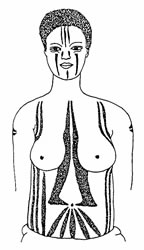
|
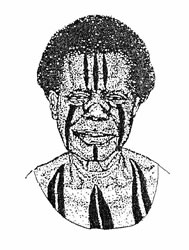 |
| Bini “blade” tattoos. |
In fact, no one saved tattooed Bini, Europeans, and people from Ufe from which the royal family had originally come, was allowed to enter the palace. The absence of tattoos (iwu) was a serious handicap, as” repugnant” as the absence of circumcision and clitoridectomy.
Among the Bini, any competent person – male of female – could tattoo, usually an osiwu (“one who sculpts tattoos”) that was called forth to operate. The profession was a hereditary position and some also specialized in autopsies and circumcisions. Like in other parts of Africa, long and fine tattoos were incised with a scalpel (abee) or knife-like instrument. Pigments were derived from charred asun (Randia coriacea) leaves that produced a dark blue-black color. As the wounds healed, their wounds were salved with medicinal substances like palm oil, soot, and the charred root of the elu (indigo) tree to suppress the formation of keloids that were regarded as unattractive.
It was said that in ancient times no Bini man would marry a woman without tattoos. This custom was verified in more recent times by the small number of men and women who continue to carry the designs of their ancestors. For example, one Bini woman reported that she received her tattoos at age thirteen, just after her first menses. Five years later her torso was tattooed prior to marriage. Her parents arranged for the “surgery,” but her future husband provided her with an “incision feast” to commemorate the event. Years later she had the tattoos redone because they were fading. Women’s tattoos were “blade-like” and positioned in various configurations on the body. Women who acquired their tattoos by royal command owned seven of the “blades” that indicated that they were suitable to join the harem of the King. Women could choose the number of vertical forehead tattoos that also appeared on their cheeks and chin.
It is said that the practice of tattooing originated in the 16th century. The King at that time married the daughter of a neighboring Yoruba ruler. However, she refused to consummate the marriage because the Bini King did not have tribal markings. The enraged ruler abused her and word of his actions reached the daughter’s father. Soon afterwards, the King and his wife visited the father-in-law at his palace. The woman’s father immediately attacked the abusive husband with a cutlass and the King’s body thereafter bore the scars of the assault. So as not to embarrass their King, his subjects imitated them on their bodies with pigment.
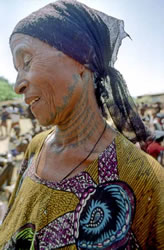
The Amharic people of the northern Ethiopia have a rich tattooing tradition that perhaps stretches back to 330 A.D. when their people converted to Christianity. Many wear the distinctive “iron hand” cross as a tattoo on their sternum or foreheads that resembles the sun and acts as a talisman to ward off evil spirits or permanently mark their devotion to God. The neck is similarly crossed with rows of interconnected cruciforms. Symbolically, the “Tree of Life” of the early Christian tradition is generally believed to be the originating element of these crucifix tattoos, although some scholars suggest another source. Photograph © Lars Krutak |
|
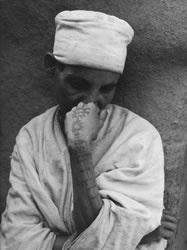
Amharic tattooing of Ethiopia. Photograph © Mario di Salvo |
Yoruba
There are several varieties of body markings and scars among the Yoruba but kolo are pigmented cicatrices that look and feel like raised keloids. According to the art historian Henry Drewal who lived with the tribe in the 1970s, the permanent designs served a variety of purposes including beautification and especially proclaiming the courage of those individuals who bore them.
Women were the primary recipients and Yorubas often commented that kolo are a “test” for the brave to endure so that they will be praised after their painful skin-cut tattoos have healed. Essentially, the patterns were acquired before marriage and prepared the woman for childbirth. They were not applied all at once, and were gradually obtained since aesthetic value was inextricably bound to their value.
Although physical appearances were highly esteemed in Yoruba society, the concept of outward beauty could not be separated from its complimentary interior dimension. As Drewal has noted:
Outer appearance may either hide or reveal one’s inner, or spiritual self. The Yoruba prayer, “may my inner head not spoil the outer one” cautions one to conceal and control negative tendencies because they can affect outer appearance and, therefore, can draw hostility from others. Conversely, positive attributes such as courage should be displayed openly, for Yoruba assess an individual’s personality both from physical appearance and behavior. Thus, elaborate body markings would be viewed as permanent and highly visible proof of one’s courage, fortitude, and strength – qualities that parallel those of the patron of body artists, the God of Iron, Ogun. [Fig 10A,B]
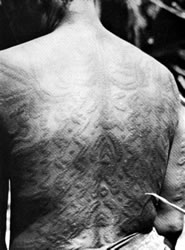 |
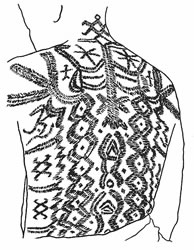 |
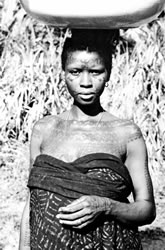 |
| Drawings and photographs of tattooed Yoruba woman, ca. 1975. All images © Henry Drewal. |
For these reasons, Yoruba tattoo masters were highly sought after and were held in great regard. They were called oniisonon or “skilled designer” or “one who creates art.” Renowned tattooists were praised for their speed, skill, dexterity, and technique. Some were quite famous since “200 faces know [them].”
Skin artists of the highest caliber mastered a repertoire of many kinds of cuts, from long and bold facial incisions (ko ture), to broad slashing cuts (keke), and bu abaja or short, shallow and faint designs, among others.
Most Yoruba motifs were derived from nature and featured cowrie shells (esa), lizards (alangba), palm trees (igi ope), arrows (ofa), ostrich (ogongo), vulture (igun), dove (adaba), chameleon (agemo), centipede (okun), butterfly (labalaba), corn cobs (agbado), and the “moon of honor” (osu ola). Other motifs were taken from the material world and encompassed dancewands (ose) of the Thunder God Sango, Islamic writing boards (walaa), arm amulets (apa tira), a king’s crown (ade oba), staffs of authority (opa oye), game boards (opon ayo), anthropomorphs, the tattooist’s Y-shaped blade (abe), and even scissors, airplanes, wristwatches, and personal names in recent times. Sometimes one or more of these designs were combined into composite and highly symmetrical motifs that were employed to decorate specific body parts and were named accordingly (e.g., “vagina design” placed on a woman’s thigh; “platform for the chest,” “back of the hand or leg,” “husband sits on lap [thigh]” and “carving the abdomen”).
Other Yoruba incisions were medicinal in nature, but instead of inserting soot or lampblack into these wounds body artists, priests, and village healers administered a variety of herbal remedies. Typically speaking, the location of such treatments corresponded to local ailments so, for example, short vertical marks placed beneath the eyes of children were incised to prevent them from trembling, a condition believed to have been brought to the living by spirits. Incisions infused with herbs near the mouth might add to a hunter’s courage and increase his memory, while medicines rubbed into cuts below the lip may have enhanced an individual’s curses against another since; “when the individual wishes to curse he licks his lower lip and whatever he says will come to pass.”
Finally, these potent substances were also employed to attract specific deities or their spiritual familiars into the bodies of the initiated. To accomplish such goals, small cuts were made on the crown of the devotee’s head and special herbs were then applied to “activate” the vital essence of the god. Small tufts of hair (osu) mark the location of these magical devices.
Next Page | 1
|
2 | 3 |
4 |
5 |
6 |
7 |
8 |
Museum photo gallery of the images
on this page may be seen here. |







